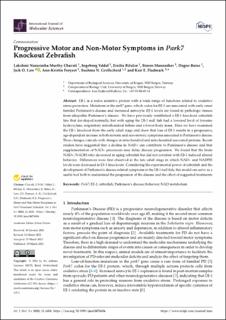| dc.contributor.author | Chavali, Lakshmi Narasimha Murthy | |
| dc.contributor.author | Yddal, Ingeborg | |
| dc.contributor.author | Bifulco, Ersilia | |
| dc.contributor.author | Mannsåker, Simen | |
| dc.contributor.author | Røise, Dagne | |
| dc.contributor.author | Law, Jack Owen | |
| dc.contributor.author | Frøyset, Ann Kristin | |
| dc.contributor.author | Grellscheid, Sushma Nagaraja | |
| dc.contributor.author | Fladmark, Kari Espolin | |
| dc.date.accessioned | 2024-01-16T12:54:46Z | |
| dc.date.available | 2024-01-16T12:54:46Z | |
| dc.date.created | 2023-06-27T13:40:14Z | |
| dc.date.issued | 2023 | |
| dc.identifier.issn | 1661-6596 | |
| dc.identifier.uri | https://hdl.handle.net/11250/3111854 | |
| dc.description.abstract | DJ-1 is a redox sensitive protein with a wide range of functions related to oxidative stress protection. Mutations in the park7 gene, which codes for DJ-1 are associated with early onset familial Parkinson’s disease and increased astrocytic DJ-1 levels are found in pathologic tissues from idiopathic Parkinson’s disease. We have previously established a DJ-1 knockout zebrafish line that developed normally, but with aging the DJ-1 null fish had a lowered level of tyrosine hydroxylase, respiratory mitochondrial failure and a lower body mass. Here we have examined the DJ-1 knockout from the early adult stage and show that loss of DJ-1 results in a progressive, age-dependent increase in both motoric and non-motoric symptoms associated to Parkinson’s disease. These changes coincide with changes in mitochondrial and mitochondrial associated proteins. Recent studies have suggested that a decline in NAD+ can contribute to Parkinson’s disease and that supplementation of NAD+ precursors may delay disease progression. We found that the brain NAD+/NADH ratio decreased in aging zebrafish but did not correlate with DJ-1 induced altered behavior. Differences were first observed at the late adult stage in which NAD+ and NADPH levels were decreased in DJ-1 knockouts. Considering the experimental power of zebrafish and the development of Parkinson’s disease-related symptoms in the DJ-1 null fish, this model can serve as a useful tool both to understand the progression of the disease and the effect of suggested treatments. | en_US |
| dc.language.iso | eng | en_US |
| dc.publisher | MDPI | en_US |
| dc.rights | Navngivelse 4.0 Internasjonal | * |
| dc.rights.uri | http://creativecommons.org/licenses/by/4.0/deed.no | * |
| dc.title | Progressive Motor and Non-Motor Symptoms in Park7 Knockout Zebrafish | en_US |
| dc.type | Journal article | en_US |
| dc.type | Peer reviewed | en_US |
| dc.description.version | publishedVersion | en_US |
| dc.rights.holder | Copyright 2023 The Author(s) | en_US |
| dc.source.articlenumber | 6456 | en_US |
| cristin.ispublished | true | |
| cristin.fulltext | original | |
| cristin.qualitycode | 1 | |
| dc.identifier.doi | 10.3390/ijms24076456 | |
| dc.identifier.cristin | 2158686 | |
| dc.source.journal | International Journal of Molecular Sciences | en_US |
| dc.identifier.citation | International Journal of Molecular Sciences. 2023, 24 (7), 6456. | en_US |
| dc.source.volume | 24 | en_US |
| dc.source.issue | 7 | en_US |

